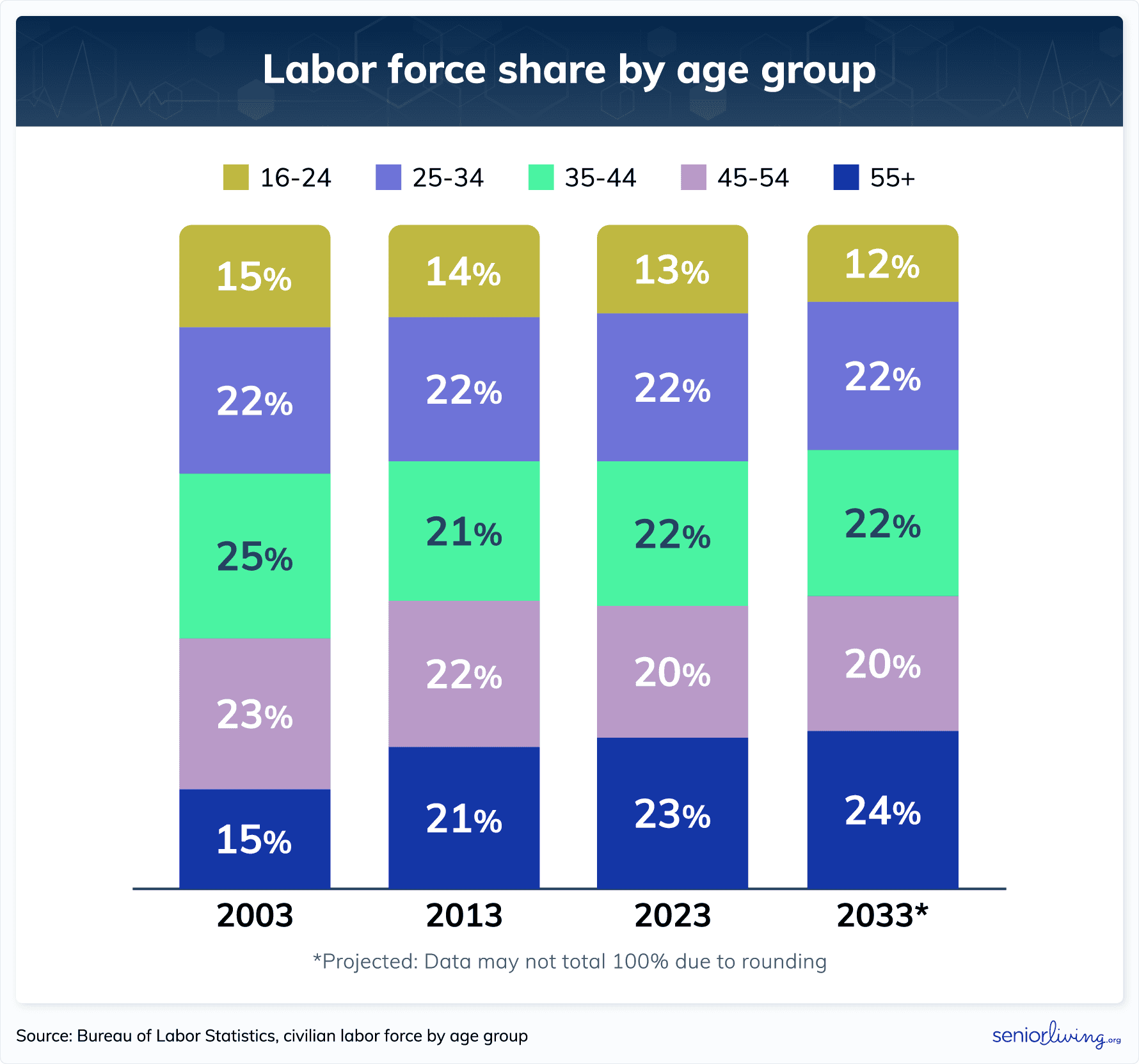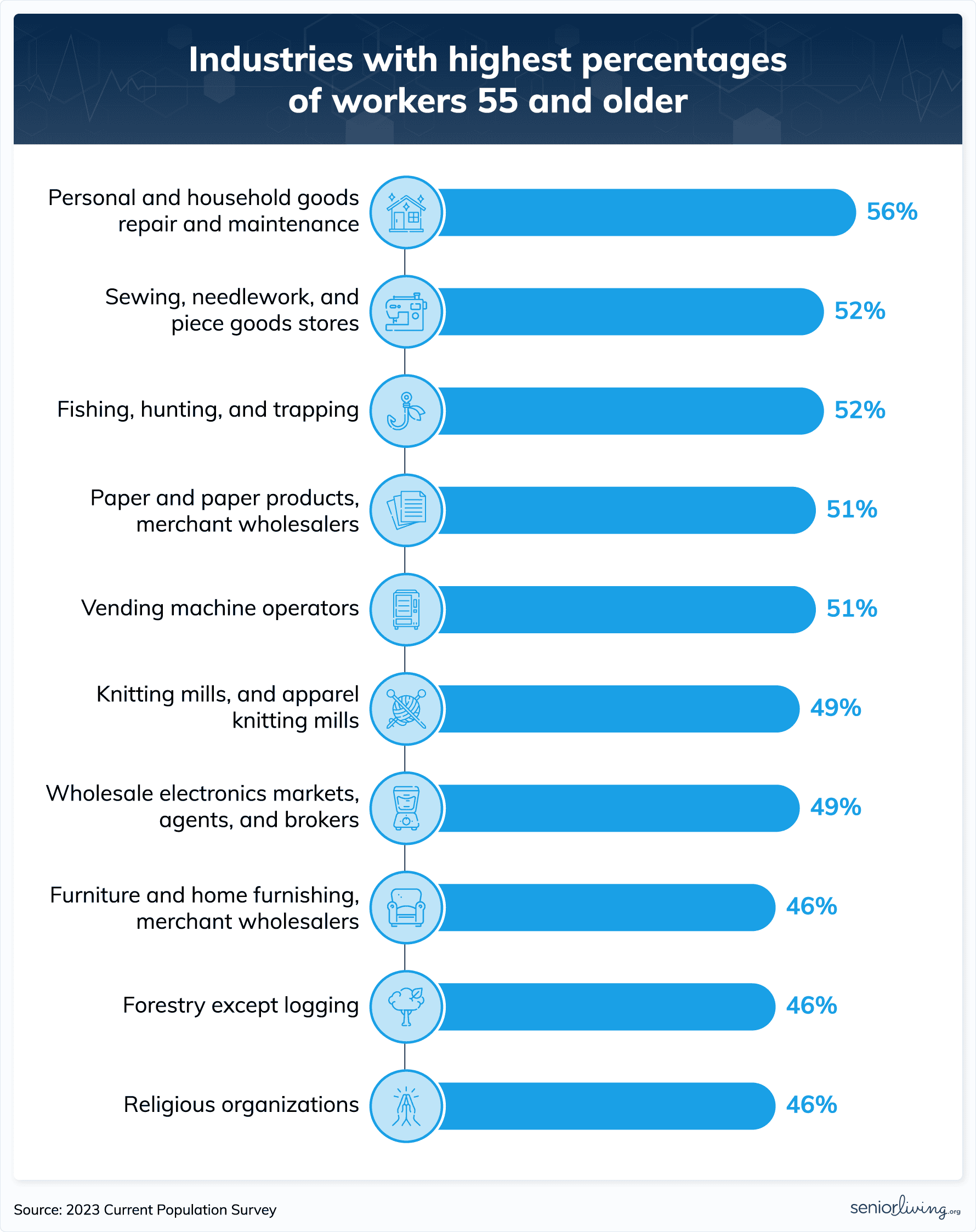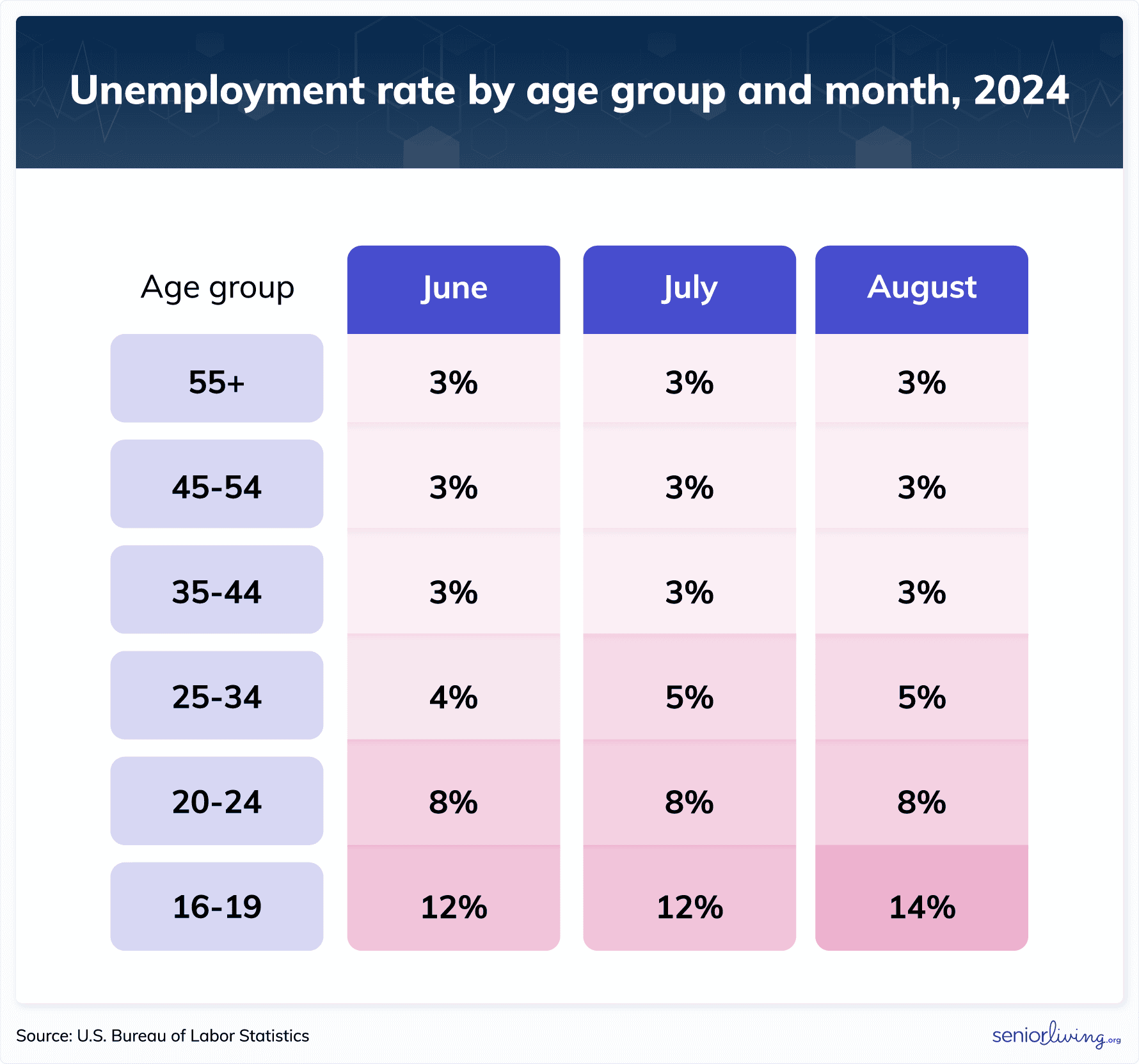2024 Senior Employment Statistics
How many older adults are working in the U.S.?
While older workers don’t make up the majority of the American workforce, they do represent a huge swath. According to the U.S. Bureau of Labor Statistics (BLS), by 2033, about one in four American workers will be 55 or older.
This represents a considerable change from decades past. In 2003, just over 15 percent of U.S. workers were 55 or older, the same percentage as college-aged or younger. No other age group has seen a more significant swing over the past 20 years.

What states have the most older workers?
Nationally, 23 percent of workers are 55 or older, but this varies dramatically from state to state. For example, in Delaware and Maine, that figure is closer to 31 percent; on the other end, about 16 percent of workers in D.C. are 55 and older.
| States with the highest percentage of older workers | States with the lowest percentage of older workers | ||
|---|---|---|---|
| Delaware | 31% | District of Columbia | 16% |
| Maine | 31% | Utah | 18% |
| Vermont | 30% | Texas | 20% |
| Connecticut | 30% | Idaho | 21% |
| Hawaii | 29% | Tennessee | 21% |
Delaware, Maine, Vermont, Connecticut, and Hawaii may have higher shares of older workers due to a mix of population and economic trends. First off, Maine, Vermont, Delaware, and Hawaii have some of the highest percentages of older people in their populations, which means more older folks in the workforce. Of course, the rising costs of living also play a role. In pricier places like Connecticut and Hawaii, older workers might be sticking around longer just to keep up with their bills. They're not ready to retire if it means downsizing their lifestyle.
Additionally, according to the American Community Survey, these five states had the greatest year-over-year increases in the number of older workers:
- Nevada (16%)
- Missouri (14%)
- Arizona (14%)
- Kansas (11%)
- Georgia (7%)
Popular industries among older workers
A handful of sectors have disproportionately high rates of older workers. For example, nearly 56 percent of people employed in the personal and household goods repair and maintenance industry are over 55.
Industries such as repair work, fishing, or sewing require highly specialized skills often gained through long-term practice. In these sectors, older workers with seniority would be particularly valuable. Some industries, like religious organizations, might have a higher share of older worker because fewer young people are joining them. This dynamic may motivate older workers to delay their retirement plans.
Some of the sectors above have experienced less technological disruption than other sectors, allowing older workers to continue using familiar methods and skills. Some, like repair or specialty stores, also have high rates of self-employment or small business ownership, roles often filled by more experienced individuals. While some jobs in these fields can be physically demanding, others may allow for adaptations that enable older workers to continue working as they age.
According to the Current Population Survey, these industries have had the greatest year-over-year growth in the number of older workers:
- Oil and gas extraction
- Office supplies and stationery stores
- Shoe stores
- Wholesale electronics markets, agents and brokers
- Tobacco manufacturing
Unemployment among older workers
Joblessness tends to be less common among older workers compared to younger professionals. In its most recent publication, the BLS indicated that just over four percent of workers were unemployed, noting a slight decline between July and August. In that same period, just three percent of workers 55 and older were unemployed, compared to 14 percent of teenagers and nearly eight percent of workers 20-24.
What older workers earn
Not only are older workers making up a more significant share of the overall workforce, but they’re also earning more than they did in decades past. In 1987, the typical hourly wage for workers 65 and up was $13; today, it’s $22, according to Pew Research Center analysis.
According to the U.S. Census Bureau, the average household earnings of Americans 60 and older are just under $90,000, while about 11 percent live below the poverty line. By comparison, about 12 percent of Americans of all ages are living below the poverty level.
As with employment figures, income and poverty rates for older Americans vary by state. Average household earnings for those 60 and older are highest in D.C. (more than $170,000) and lowest in Mississippi (about $80,000). However, D.C. also ranks in the top 10 for the percentage of adults 60 and older whose households are below the poverty line (14 percent).
Average household earnings and poverty rates
Among adults 60 and older, by state
| State | Average household earnings | Percent of people age 60 or older living below the poverty line |
|---|---|---|
| District of Columbia | $170,985 | 14% |
| Massachusetts | $144,826 | 10% |
| New Jersey | $142,462 | 10% |
| California | $135,931 | 12% |
| Washington | $133,833 | 10% |
| Connecticut | $133,097 | 10% |
| Maryland | $130,900 | 10% |
| New York | $129,057 | 14% |
| New Hampshire | $126,663 | 7% |
| Virginia | $124,204 | 10% |
| Colorado | $124,129 | 9% |
| Hawaii | $119,154 | 10% |
| Rhode Island | $116,403 | 11% |
| Utah | $116,038 | 9% |
| Minnesota | $115,963 | 9% |
| Illinois | $114,968 | 12% |
| Oregon | $109,248 | 12% |
| Delaware | $108,060 | 11% |
| Alaska | $107,694 | 10% |
| Arizona | $107,562 | 12% |
| Texas | $106,792 | 14% |
| Pennsylvania | $106,559 | 12% |
| Georgia | $105,623 | 14% |
| Vermont | $105,235 | 10% |
| Florida | $104,490 | 12% |
| Nevada | $102,051 | 12% |
| Nebraska | $100,419 | 11% |
| Wisconsin | $99,892 | 11% |
| North Carolina | $99,781 | 13% |
| Maine | $97,997 | 10% |
| Michigan | $97,574 | 14% |
| Idaho | $97,271 | 10% |
| North Dakota | $97,139 | 10% |
| Ohio | $96,652 | 13% |
| Tennessee | $96,261 | 14% |
| South Dakota | $96,223 | 12% |
| Missouri | $94,894 | 12% |
| Indiana | $94,673 | 12% |
| Iowa | $94,207 | 11% |
| Kansas | $93,976 | 11% |
| South Carolina | $93,171 | 14% |
| Montana | $91,566 | 12% |
| Wyoming | $90,011 | 11% |
| Alabama | $88,203 | 16% |
| Louisiana | $88,101 | 19% |
| Kentucky | $87,909 | 16% |
| Oklahoma | $87,434 | 16% |
| New Mexico | $85,311 | 18% |
| Arkansas | $85,132 | 16% |
| West Virginia | $81,642 | 17% |
| Mississippi | $79,888 | 18% |
Source: 2023 1-year estimates, American Community Survey
Retirement savings goals push older employees to keep working
According to figures from the BLS, about 900,000 Americans over 75 were part of the labor force in 2023. Today, that number is nearly two million and by 2033, the BLS expects the figure to exceed 3.5 million. Doubtless, some of these people simply wish to continue working. However, it’s impossible to ignore the reality that many people well past retirement age are still in the workforce because they cannot afford to retire.
A recent AARP survey found that about one in five Americans 55 and older have no retirement savings, and 61 percent are worried they won’t have enough money to support themselves in retirement.
While personal choices certainly play a role — careers, geography, parenthood, and more — some economists have looked at broader factors. For example, the most common type of retirement plan has changed, placing workers in a much more precarious situation.
In the 1980s and 1990s, many employers shifted from defined benefit retirement plans, pensions, to defined contribution plans like 401(k) or IRA plans. With a pension, most contributions come from employers and benefits are drawn from a pool, but with plans like IRAs and 401(k)s, most contributions come from employees and benefits are drawn from individual accounts.
In 1989, about 41 percent of families had a pension-style retirement plan, 35 percent had a 401(k) plan, and 17 percent had both. By 2016, only 19 percent had pensions, 44 percent had 401(k)s, and nine percent had both.
We’ve already established that a disturbing share of older Americans lack adequate retirement savings, and research finds that many older people have serious regrets about not putting enough aside.
One survey indicated that 58 percent of people between age 60 and 79 had a lot of savings regret, wishing they’d built up their retirement coffers more.
However, while the data suggests older adults today are likely facing a trickier scenario than their parents, most older Americans remain upbeat about the future, and a majority say the American dream is very real — because they’re living it.
A Pew survey in 2024 found that 57 percent of Americans 65 and older say they’ve achieved the American dream. For comparison, only 39 percent of people 18-29 believe the American dream is achievable at all.
What are working conditions like for older employees?
As we age, our bodies go through normal changes that often make daily life more difficult, including while we’re at work. An Economic Policy Institute analysis found that about half of workers over age 50 have physically demanding jobs. Fifty-four percent had jobs involving health or other types of hazards and 54 percent also reported they had jobs with demanding work hours.
A BLS analysis also indicated that compared to all employees, older workers are more likely to be fatally injured on the job. Data also showed that while all workers saw fatal workplace injuries fall between 1992 and 2017, older workers experienced 56 percent more fatal work injuries.
Age discrimination
The age and experience of older workers are clearly assets in the workforce, but they can also be a detriment. An AARP survey in 2023 showed that 90 percent of workers 50 and older believe ageism is common in the workplace, and one-quarter said they’d heard negative comments about an older coworker’s age in the recent past.
Reskilling & upskilling
Modern workplaces change fast as trends and technology pop up on a seemingly endless cycle. For workers resistant to change, this can be disturbing, but for those interested in learning new skills, change can become an opportunity.
The presence of computer technology across society means that today’s older workers are likely better equipped to learn new technology-based skills than people in their parents’ generation. According to an AARP survey, nearly half of workers 50 and older have shown interest in training classes in computers and technology, and 60 percent said they’re willing to learn new skills if their current or potential future employer asks them to.
Workplace satisfaction
Despite the challenges they face in a rapidly evolving workplace, older workers are more likely than their younger counterparts to report being satisfied at work. A 2023 Pew survey showed that while only 51 percent of all workers were satisfied with their job overall, 66 percent of workers 65 and up said the same.
Like their younger counterparts, older workers have rolled with the punches of the COVID-19 pandemic, dealing with a shift to remote work and, now, a return-to-office requirement expected by a growing number of employers. According to an AARP survey, they’re also benefitting from a greater focus on worker well-being. The survey found that 71 percent of workers 50 and older believe their current workplace promotes their overall well-being.
Conclusion
As the American workforce continues to age, older workers are becoming an increasingly vital part of the economy, bringing their valuable experience and specialized skills to the workforce. While the pressure to save for retirement and keep up with rising living costs often drive this trend, the benefits of work for seniors extend far beyond monetary rewards. Employment provides older adults with opportunities to stay physically and mentally active, maintain a sense of purpose, and forge meaningful social connections across generations.
However, challenges such as age discrimination and concerns about retirement savings persist. Moving forward, it's crucial for employers and policymakers to create inclusive work environments that not only leverage the expertise of older workers but also support their unique needs and enhance their overall well-being. By doing so, we can ensure that work continues to be a source of fulfillment, social engagement, and economic stability for older and younger Americans alike.


